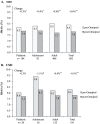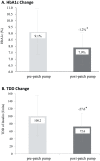Novel Bluetooth-Enabled Tubeless Insulin Pump: Innovating Pump Therapy for Patients in the Digital Age
- PMID: 30239214
- PMCID: PMC6313290
- DOI: 10.1177/1932296818798836
Novel Bluetooth-Enabled Tubeless Insulin Pump: Innovating Pump Therapy for Patients in the Digital Age
Abstract
The Omnipod DASH™ Insulin Management System (Insulet Corp, Billerica, MA) is a discreet, tubeless, wearable insulin pump that holds up to 200 units of U-100 insulin and delivers therapy through customizable basal rates and bolus amounts. This recently FDA-cleared system consists of the insulin pump ("Pod"), which is worn on body and delivers insulin, and the Personal Diabetes Manager (PDM), which is a handheld device used to wirelessly control and monitor the Pod functionality. The PDM can also be paired with the CONTOUR® NEXT ONE blood glucose (BG) meter (Ascensia Diabetes Care, Basel, Switzerland) to wirelessly receive BG readings. This review provides a detailed description of the Pod and PDM. Key features of the Pod are described, including the novel pump delivery mechanism, waterproof (IP28) housing design, and automated cannula insertion. The technology introduced in the new system, such as touchscreen PDM interface, Bluetooth® wireless technology, and wireless internet connectivity, is also presented. Last, Omnipod® Insulin Management System clinical data are reviewed, including early feasibility results for the Omnipod Horizon™ Automated Glucose Control hybrid closed-loop system.
Keywords: Omnipod; diabetes; insulin pump; patch pump; tubeless pump.
Conflict of interest statement
Figures





Similar articles
-
Novel Bluetooth-Enabled Tubeless Insulin Pump: A User Experience Design Approach for a Connected Digital Diabetes Management Platform.J Diabetes Sci Technol. 2018 Nov;12(6):1132-1142. doi: 10.1177/1932296818804802. Epub 2018 Oct 11. J Diabetes Sci Technol. 2018. PMID: 30304951 Free PMC article.
-
Review of the Omnipod® 5 Automated Glucose Control System Powered by Horizon™ for the treatment of Type 1 diabetes.Ther Deliv. 2020 Aug;11(8):507-519. doi: 10.4155/tde-2020-0055. Epub 2020 Jul 28. Ther Deliv. 2020. PMID: 32723002 Free PMC article. Review.
-
Concept and Implementation of a Novel Patch Pump for Insulin Delivery.J Diabetes Sci Technol. 2020 Mar;14(2):324-327. doi: 10.1177/1932296819871626. Epub 2019 Aug 27. J Diabetes Sci Technol. 2020. PMID: 31452394 Free PMC article.
-
Safety and Feasibility of the OmniPod Hybrid Closed-Loop System in Adult, Adolescent, and Pediatric Patients with Type 1 Diabetes Using a Personalized Model Predictive Control Algorithm.Diabetes Technol Ther. 2018 Apr;20(4):257-262. doi: 10.1089/dia.2017.0346. Epub 2018 Feb 12. Diabetes Technol Ther. 2018. PMID: 29431513 Free PMC article.
-
Patch Pumps for Insulin.J Diabetes Sci Technol. 2019 Jan;13(1):27-33. doi: 10.1177/1932296818786513. Epub 2018 Aug 2. J Diabetes Sci Technol. 2019. PMID: 30070604 Free PMC article. Review.
Cited by
-
Patch Pumps: Periodic Insulin Delivery Patterns.J Diabetes Sci Technol. 2023 Jul;17(4):1049-1055. doi: 10.1177/19322968221091843. Epub 2022 Apr 25. J Diabetes Sci Technol. 2023. PMID: 35466704 Free PMC article.
-
Insulin Pumping Patches: Emerging Insulin Delivery Systems.J Diabetes Sci Technol. 2019 Jan;13(1):8-10. doi: 10.1177/1932296818814541. Epub 2018 Nov 22. J Diabetes Sci Technol. 2019. PMID: 30466305 Free PMC article.
-
Novel Bluetooth-Enabled Tubeless Insulin Pump: A User Experience Design Approach for a Connected Digital Diabetes Management Platform.J Diabetes Sci Technol. 2018 Nov;12(6):1132-1142. doi: 10.1177/1932296818804802. Epub 2018 Oct 11. J Diabetes Sci Technol. 2018. PMID: 30304951 Free PMC article.
-
Development and validation of a distress measurement for insulin injections among patients with diabetes.Sci Rep. 2023 Jul 20;13(1):11725. doi: 10.1038/s41598-023-38982-1. Sci Rep. 2023. PMID: 37474582 Free PMC article.
-
Review of the Omnipod® 5 Automated Glucose Control System Powered by Horizon™ for the treatment of Type 1 diabetes.Ther Deliv. 2020 Aug;11(8):507-519. doi: 10.4155/tde-2020-0055. Epub 2020 Jul 28. Ther Deliv. 2020. PMID: 32723002 Free PMC article. Review.
References
-
- Insulet Corporation. User Guide: Omnipod DASH™ Insulin Management System. Billerica, MA: Insulet Corporation; 2018.
-
- Danne T, Schwandt A, Biester T, et al. Long-term study of tubeless insulin pump therapy compared to multiple daily injections in youth with type 1 diabetes: data from the German/Austrian DPV-registry. Pediatr Diabetes. 2018;19(5):979-984. - PubMed
Publication types
MeSH terms
Substances
LinkOut - more resources
Full Text Sources
Other Literature Sources
Medical

